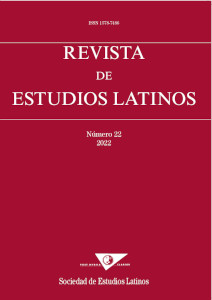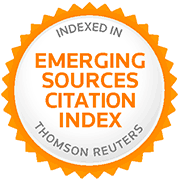From the origin of the term triō, -ōnis ‘yoke of oxen’ to metaphor Septentriones ‘Polar bears’
DOI:
https://doi.org/10.23808/rel.v22i0.96917Keywords:
etymology, singular collective, yoke of oxen, stellar metaphors, triangle figure.Abstract
Trio, -onis does not derive from terere ‘to break up, to crumble’ the earth, as has been believed since ancient times, nor does it express the meaning of ‘ox’, but rather that of ‘yoke’. Varro and Aulus Gellius refer to the pair of oxen in a yoke as a triangle, but they do not indicate what is the third point in the triangle. We understand that the ploughman who is driving the plough completes the missing angle. Thus we propose that trio, -onis is a ‘collective’ derivative of tres, tria, with formation similar to that of binio or quatrio in a game of dice. Therefore, the compound Septentriones designates the Seven Yokes that pull each of the twin constellations at the North Pole. In this metaphorical transposition, the celestial yokes do not pull ploughs, but rather the Chariot. They do retain their triangular configuration, however, as the two Latin authors maintain. To this we can add that, for the catasterization to be complete, the load carried by the Seven Yokes is distributed in triangles from the shaft to the end of the Chariot
Downloads
References
Alvar Ezquerra, A. (1990): D. M. Ausonio, Obras II, Traducción y Notas, Madrid, Gredos.
André, J. (1962): “Notes philologiques”, Revue de Philologie 36, 23-35.
Baldinger, K. (1970): Teoría semántica. Hacia una semántica moderna, Madrid, Ediciones Alcalá.
Belardi, W. (1950): « Septemtrio », Maia 3, 57-58.
Chantraine, P. (1962): Dictionnaire étymologique de la langue grecque, París, Klincksieck.
Commelerán y Gómez, F. A. (1912): Diccionario latino-español, Madrid, Sucesores de Hernando.
De Vaan, M. (2008): Etymological Dictionary of Latin and the other Italic Languages, Leiden, Brill.
DGE = Rodríguez Adrados, F. & al.: Diccionario Griego-Español, Madrid, CSIC. [09/08/2022].
DLE = Real Academia Española (232014): Diccionario de la lengua española, Madrid, Espasa-Calpe. <https://dle.rae.es> [09/08/2022].
Ernout, A. & Meillet, A. (2001): Dictionnaire étymologique de la langue latine. Histoire des mots, París, Klincksieck.
Flobert, P. (2019): Varron, La langue latine, livre VII . Texte établi, traduit et commenté, París, Les Belles Lettres.
Forcellini, A. (1965 [1771]): Lexicon totius latinitatis, Florencia, Forni.
Gaffiot, F. (2000): Dictionnaire latin-français, éd. de P. Flobert, París, Hachette - Livre.
Georges, K. E. (1969): Ausführliches lateinisch-deutsches Handwörterbuch, Basilea / Stuttgart, Schwabe & CO.
Glare, P. G. W., ed., (1985): Oxford Latin dictionary, Óxford, Clarendon Press.
Heifetz, M. D. & Tirion, W. (2022): Un paseo por las estrellas. Una guía de las estrellas, las constelaciones y sus leyendas, Madrid, Akal.
Hernández Miguel, L. A. (1998): M. T. Varrón, La lengua latina: libros VII-X y fragmentos, Madrid, Gredos.
Kent, R. G. (1967): Varro, De lingua latina, Londres, Heinemann & Cambridge Mass., Harvard University Press.
Lasagna, M. (2010): “Le lexique du nombre ‘trois’ dans le Gryphus ternarii numeri d’Ausone”, en Fruyt, M. et Spevak, O. (éds.), La quantification en latin, París, L’Harmattan, 409-424.
Le Boeuffle, A. (1977): Les noms latins d’astres et de constellations, París, Les Belles Lettres.
Leumann, M. (1977): Lateinische Laut- und Formenlehre, Múnich, Beck.
Lewis, Ch. T. & Short, Ch. (1984 [1979]): Latin dictionary, Nueva York, Oxford University Press.
Marcos Casquero, M. A. (1990): M. T. Varrón, De lingua latina, Introducción, traducción y notas, Barcelona, Anthropos.
Pokorny, J. (1959): Indogermanisches etymologisches Wörterbuch, Berna, Francke.
Robert, C. (ed.) (1963): Eratosthenis Catasterismorum reliquiae, Berlín, Weidmann.
Rolfe, J. C. 1970: The Attics Nights of Aulus Gellius, Cambridge Mass., Harvard University Press & Londres, Heinemann.
Ruiz de Elvira, A. (1964): P. Ovidio Nasón, Metamorfosis, vol. I, Barcelona, Ediciones Alma Mater.
Sánchez Crespo, Á. (2019): De Madrid al cielo. Dichos y frases de Madrid, Madrid, Guadarramistas Editorial.
Scherer, A. (1953): Gestirnnamen bei den indogermanischen Völkern, Heidelberg, Winter.
Segura Moreno, M. (1984): Q. Ennio, Fragmentos, Madrid, CSIC.
Szemerényi, O. (1962): “Principles of etymological research in the Indo-European languages”, en II. Fachtagung für indogermanische und allgemeine Sprachwissenschaft, Innsbruck, Universität Innsbruck, 175-212.
TLL = Thesaurus linguae latinae, Leipzig, Teubner / Berlín, De Gruyter, 1900 ss.
Walde, A. & Hofmann, J. B. (1986): Lateinisches etymologisches Wörterbuch, Heidelberg, Winter.
Zamboni, A. (1988): La etimología (versión esp. de P. García Mouton), Madrid, Gredos.
Downloads
Published
How to Cite
Issue
Section
License
Copyright (c) 2022 Revista de Estudios Latinos

This work is licensed under a Creative Commons Attribution-NonCommercial-NoDerivatives 4.0 International License.
The originals published in the printed and electronic editions of this journal are the property of the Revista de Estudios Latinos and can be circulated as long as the original source and authorship is made clear in any reproduction, full or partial, of the same, and as long as this is not done for commercial purposes.








